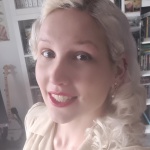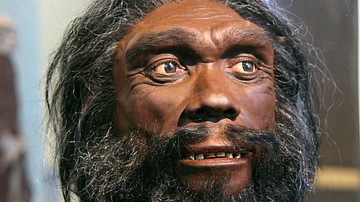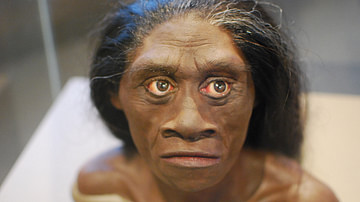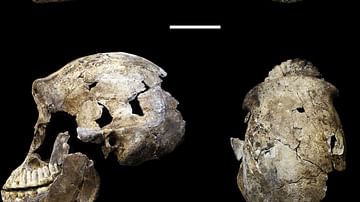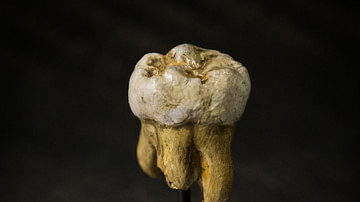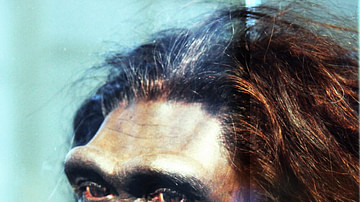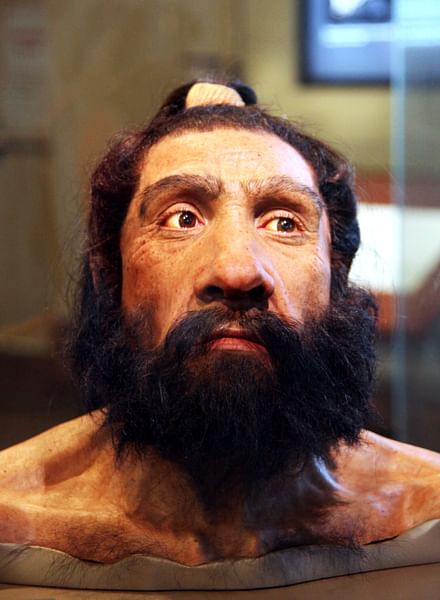
Neanderthals are an extinct group of fossil humans that appeared in Western Eurasia in the mid-Middle Pleistocene and shared the stage with the first modern humans arriving in Europe from around 45,000 years ago, before disappearing from the fossil record around 40,000 years ago. Neanderthals were a highly successful group, having adapted well to the unpredictable climate of a region in which advancing and retreating ice sheets were no strangers. Their short, stocky build made them sturdy and powerful, while their large brains fuelled their capability of hunting even the biggest Ice Age creatures such as mammoths or woolly rhinoceros.
We – modern humans – are tied to Neanderthals in many ways, from sharing a common ancestor down the line, back in Africa, between c. 550,000-c. 750,000 years ago, to coexisting in Europe for some time. There, the two must have competed for resources, but are also known to have interbred with each other, causing the Neanderthals to have had a genetic impact on us still visible in our DNA today. Another human species, the Denisovans, are tied to the Neanderthals even more closely than us modern humans are: the two are sister groups that diverged from a common ancestor more than 390,000 years ago, perhaps between 430,000-473,000 years ago – a later split than that with modern humans. The Denisovans are so far only known from Denisova Cave in the Altai Mountains in Siberia, a site at which Neanderthal remains have also been found. The most astonishing discovery made there and a very direct example of the fact that Neanderthals also interbred with the Denisovans came in 2012 CE, when a long bone fragment dated to between c. 80,000 and 120,000 years old was found that belonged to a female who had a Neanderthal mother and a Denisovan father.
Discovery
When the first Neanderthal fossils were dug up in the early 19th century CE (Engis child in 1830 CE and Forbes Quarry adult in 1848 CE) they were not immediately recognized as a kind of archaic human. Instead, the skeletons' peculiar anatomy, which clearly differed from modern humans, was explained away as resulting from diseases such as rickets. However, after a skeleton was discovered in the Neander Valley in Germany in 1856 CE, the subsequent research was influenced by the publication of Darwin's On the Origin of Species in 1859 CE, and the ball began to roll. By 1864 CE the mysterious skeletons had been assigned to the species Homo neanderthalensis.
When & where did they live?
Owing to the difficulties that the process of evolution adds to the classification of species, there is no clear-cut date for the initial appearance of Neanderthals. Rather, we recognise that the first Neanderthal-like features appeared between c. 600,000-c. 400,000 years ago, with a progressively stronger expression of their morphology developing throughout time. Between 200,000 and 100,000 years ago their features are clear and recognisable, although what we see as “classic” Neanderthals, with the full set of features associated with them, did not appear until around 70,000 years ago.
Neanderthals share a common ancestor with modern humans in Africa, between c. 550,000 and c. 750,000 years ago. They are usually identified as Homo heidelbergensis, although a 2016 CE study suggests a divergence date for Neanderthals so far back in time it rules them out, and instead proposes Homo antecessor as the best candidate. Whoever it may have been, a group of this common ancestor species migrated into Europe, where it evolved not only into the Neanderthals but also into their sister group, the Denisovans, these two branches diverging more than 390,000 years ago, perhaps between 430,000-473,000 years ago. The common ancestor group that remained in Africa evolved into homo sapiens.
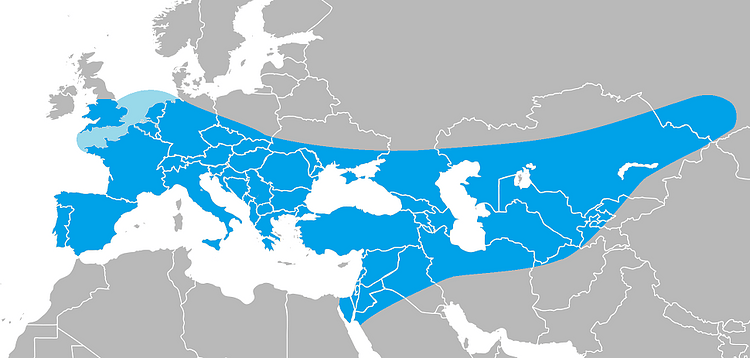
Neanderthals were very widespread: specimens have been found ranging from Spain and the Mediterranean to Northern Europe and Russia, as well as throughout the Near East, and as far east as Uzbekistan and Siberia.
Neanderthal morphology
Considering the fact that Neanderthals evolved from their predecessor in Ice Age Western Eurasia and lived there for such a length of time, they needed to be well-adapted to the often cold climate. Short and stocky, with Neanderthal men averaging around 169 cms and Neanderthal women around 160 cms tall, and sporting broad and deep ribcages, these humans had a different build than the taller and lankier modern humans. Their heavy brow ridges, large faces with appropriately large noses, and lack of chin further set them apart.
Otherwise, Neanderthals share a whole host of derived features with modern humans, among which are enlarged brains (their brain cases were even larger than ours), and they also had less of a protruding face than many earlier archaic humans. These features make Neanderthal skulls markedly different from our own. Regarding hair and skin colour, Neanderthals likely had high variability – certainly higher than the arriving modern humans. Pale skin and red hair are suggested by the DNA from two specimens from Italy and Spain, whereas darker skin and brown or red hair are indicated in three individuals from Vindija, Croatia.
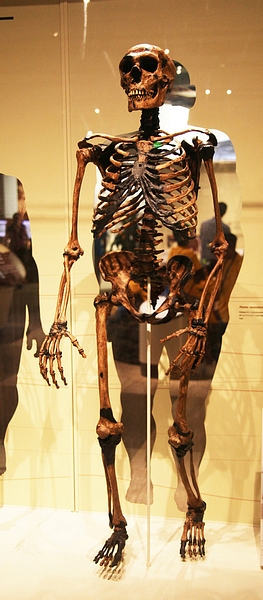
The fossil record also betrays that Neanderthals were anything but pushovers; they led harsh and dangerous lives. Almost all well-preserved adult skeletons show some sign of trauma, usually around the head or neck region, perhaps related to hunting strategies in which they had to come close to large prey animals. The fact that the majority of these lesions had healed or partially healed means that the individuals in question were socially cared for and recovered from their injuries to hunt another day. However, not everyone was that lucky; on average, Neanderthal adult life expectancy was very low, clearly owing to the physically stressful and dangerous nature of their lives.
Lifestyle
Both the powerful build and amount of trauma seen in Neanderthals indicate they were active hunters, and what we know about the high reliance on meat in their diet ties in with the amount of energy hunting would have required. They ate mostly herbivore meat, from mammals such as bison, wild cattle, reindeer, deer, ibex and wild boar. Interestingly, the very largest of the Ice Age herbivores, woolly mammoths and woolly rhinoceros, actually represent a large part of the Neanderthal diet. It would have been no mean feat to bring these animals down, even for a coordinated group of skilled hunters – which the Neanderthals would have been. Besides meat there was also a strong plant component to their diet, most likely consisting of legumes and grasses, seeds and fruits. Moreover, it is clear that Neanderthals cooked their food and maybe even knew medicinal uses of plants.
As far as the tools Neanderthals used, they are most commonly (but not exclusively) associated with Mousterian lithic technology. Flint flakes were turned into side scrapers, retouched points, and small hand-axes, usually from locally available material. Very few bone tools are known, but wooden tools were most likely used, too. From at least 200,000 years ago Neanderthals had the ability to control fire, when we know it was used as a tool to produce birch-bark pitch, although they likely used it much earlier already, as controlled use of fire appeared throughout Europe from 400,000 years ago onward.
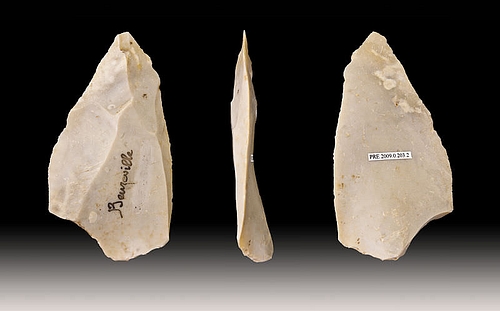
Not big on building their own structures (although exceptions are known), their fires would predominantly have lit caves or other natural shelters, in which the living areas that have been found are relatively small and a bit chaotic, showing no clear focus of activity. Hearths are well defined, though, and probably played a central role not just with regard to cooking or warmth but also for tool production.
Traditionally, Neanderthals were depicted as cognitively inferior to the arriving modern humans, with a less sophisticated culture and lack of symbolic thought that would have given our ancestors the edge. However, this image has now been overturned; Neanderthals were clearly a complex group. Besides coordinated hunting (for which effective communication is needed), caring for their wounded, advanced use of fire and tool production, Neanderthals have been known to intentionally bury their dead. Moreover, stalagmite rings built by the Neanderthals in Bruniquel cave in France, dated to 176,500 years ago, show planning, control of the underground environment, and perhaps symbolic use. They also perforated and coloured marine shells, and, strikingly, seem to have used red ochre at a site in Maastricht-Belvedère as early as a stunning 200,000-250,000 years ago, drawing it level with the time range documented for the African record for the use of ochre. These were no simple brutes, and their disappearance cannot be explained away by a large perceived gap in intelligence between our species.
Disappearance
Around 55,000 years ago, the main wave of modern humans that had left Africa met the Neanderthals in the Near- and Middle East, where they interbred. This was not the first time the two species met, however – there is also some evidence of genetic exchange between the two species happening roughly 100,000 years ago, possibly in the Near East. The later event of c. 55,000 years ago left the biggest genetic mark on our species, though, and from the Near East modern humans then spread across Eurasia, reaching Europe at the earliest around 45,000 years ago. They came in much larger numbers, both in group size and overall population density, than the present Neanderthals, who suddenly faced competition for resources. Not long after (on a prehistoric timescale, that is), around 40,000 years ago, the Neanderthals vanished from the fossil record.
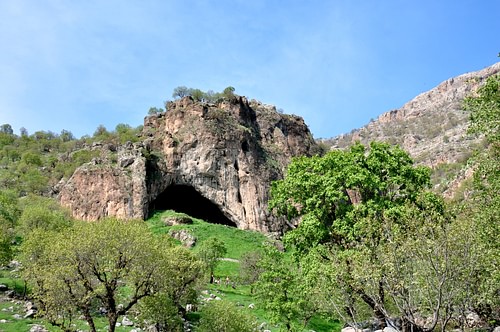
Besides competition, another factor that may have played a role in the Neanderthals' disappearance is the climate, which was much more unstable around that time than previously recognised. This may have stressed their population, which was already many times smaller than the invading modern humans' numbers, leaving them vulnerable to their impact.
Moreover, interbreeding with Neanderthals helped modern humans adapt to the colder climate in Europe, as their genes impacted our skin colour and hair. Due to our ancestors mixing with Neanderthals after leaving Africa, in total, non-African humans possess on average around ~2% Neanderthal DNA. However, the two groups were clearly only on the cusp of biological compatibility, as research has shown that interbreeding led to decreased fertility as well as miscarriages when male babies possessed a Neanderthal Y chromosome. This would have decreased the total Neanderthal genetic contribution. When combining this with the vast difference in population sizes between the two groups, it may suggest interbreeding played a significant part in explaining why Neanderthals vanished – perhaps they were partially 'absorbed' into our population. In the end, the Neanderthals' disappearance must have come down to a combination of many different factors, including vast competition, the harsh environment, as well as some measure of interbreeding. We are only beginning to uncover the exact details of the genetic influence they had on us, though, so we are definitely not done with them yet.

